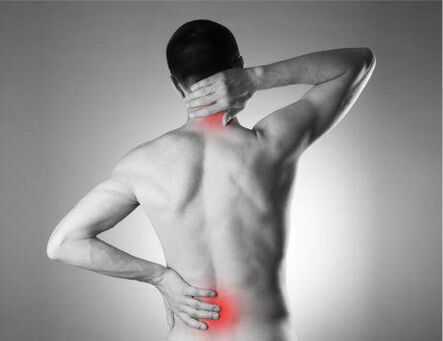With osteochondrosis, the structure and function of the intervertebral disc is affected, which gives the spine with flexibility and mobility.As the disease is increasing, irreversible changes arise in the vertebra itself.

The causes of osteochondrosis are internal (endogenous) and external (exogenous).
The endogenous cause includes:
- a violation of intrauterine development of the spine,
- descent predisposition and age -related changes in cartilage.
The main cause of osteochondrosis is the unnatural distribution of the spine, leading to the change in cartilage in places of excessive pressure.
Causing illness:
- spinal trauma,
- Infection,
- weak back muscles,
- The curvature of a bend and lateral s, the spine,
- heavy
- Long retention of uncomfortable posture.
Osteochondrosis can develop not only in people with improper posture involved in mental work, but also physically trained.
In addition to the mechanical causes for the development of osteochondrosis, they also lead to:
- metabolic disorders (especially calcium and phosphorus),
- Lack of trace and vitamin elements (magnesium, manganese, zinc, vitamin D),
- The predisposition of descent plays a large role.
When lifting weights, jumping, falling, static loads, micro intervertebral disc injuries appear.If this happens systematically, damaged intervertebral discs lose their elastic properties over time, leveling, and the distance between the vertebrae decreases.And this means that the widespread nerve root of the spinal cord is tightened, pain occurs.At the same time, swelling appears in the neuro-vascular bundle clip, leading to greater violations and increased pain.If the intervertebral disc is starting to collapse, it stops paying off, more injury, and gradually -the spine loses flexibility.
The main sign of osteochondrosis is pain.Depending on where the damaged intervertebral disc is located, they can hurt: neck, shoulders, arms, back and chest.Sometimes a person thinks that he has a heart problem, but in fact, this is a nerve pain that is compressed by osteochondrosis.At the same time as pain, one often feels overstrain and numbness from the muscles.If the blood vessels that feed the brain are squeezed, headache, dizziness, noise in the ear, double eyes, nausea and vomiting, fainting appears.
You should contact the complaint to a neurologist.He will examine the spinal column, check how the conditions are with the circulation of the cerebral, and if necessary to set radiographs, computers or the corresponding magnetic resonance tomography.
Treatment of osteochondrosis is a long process that requires someone with great strength and free time.To date, there are many ways to combat the disease: medicine, manual therapy, attractiveness, massage and therapeutic gymnastics.
Tips for the prevention of radiculitis and osteochondrosis:
- Performing correction of spinal curvature and posture disorders at the early school age.
- Actively engaged in physical education, which will allow you to form a muscle corset.
- Adhere to the diet, eat products with adequate vitamin, calcium and magnesium content (fish and other gifts from the sea, cabbage, spinach, nuts, nuts, seeds, nuts, coarse bread and fresh milk).
- Fighting with excess weight.
- When it comes to weight, make sure the uniform load on both hands, wear a backpack instead of a bag.Weight lift only with the use of the feet, not the spine.


















